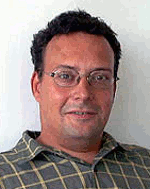 |
|
Biography
Johann Cervenka was born in Schwarzach, Austria, in 1968. He studied electrical engineering at the Technische Universität Wien, where he received the degree of Diplomingenieur in 1999. He then joined the Institute for Microelectronics at the Technische Universität Wien and received his PhD degree in 2004. His scientific interests include three-dimensional mesh generation, as well as algorithms and data structures in computational geometry.
The Deterministic Wigner Approach to Superposed States
The Wigner formalism is a convenient way of describing quantum mechanical effects through a framework of distribution functions in phase space. Generally, the Wigner method describes transport processes in a phase space representation with quasi-distribution functions. In contrast to classical probability distributions, the distribution in the Wigner view may also take negative values.
In the development of modern electronic devices, these effects have to be accounted for in the simulation of carrier transport processes. Currently, there are stochastic and deterministic approaches in use. In our deterministic method, the critical discretization of the diffusion term is done through the utilization of an integral formulation of the Wigner equation. This deterministic method was studied in the context of superposed quantum states as a precursor to simulations of entangled states.
In the subfigure on the left, the phase space distribution of two superposed wave states is shown. The transformed system results in two parts called the particular state, which can be seen on the left- and right-hand sides, plus an additional term called the correlation state, which is shown in the middle.
The resulting correlation term reveals oscillatory behavior with respect to both its x-variable and k-variable. This oscillation holds the phase information of the two base states and its period in x (or k), depending on the distance of those states in k or x, respectively. During time evolution, the particular state packets move according to their k-value. The envelopes become distorted, which leads to a narrowing in the k-space. In the subfigure on the right, the time-shifted situation is shown. The left and right packets are moved and distorted, whereas the middle packet stays centered but also distorts. This narrowing represents a challenge for the calculation of the oscillation term, caused by the discretization, if the periods are not resolved properly. A compromise between resolution and range in k-space has to be found, the influence of which must be analyzed.

Fig. 1: Contour plot of two superposed wave states. Initial time on the left, with the time shifted situation on the right.



